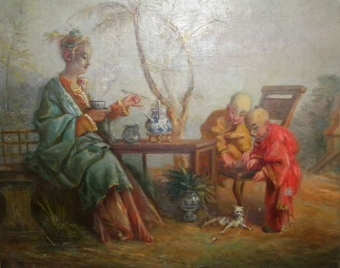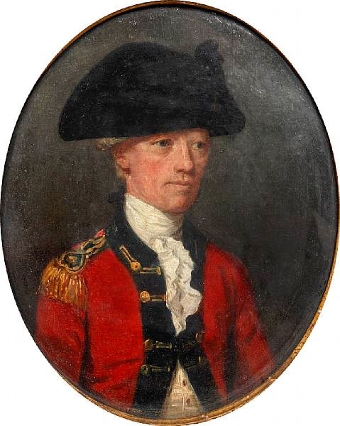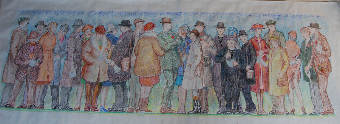the exeter exchange, popularly known as exeter change
- View other items in:
- antiques interior design modern and vintage
- other interior design
artware ltd
Enquire about this antique
Artware Ltd has 565 antiques for sale.
click here to see them all
Engraved by T. Barber. Jones & Co. Temple of the Muses, Finsbury Square, London, Nov. 7, 1829.
Thomas Hosmer Shepherd (1792 ? 1864) was a watercolor artist well known for his architectural works. Son of an architectural draughtsman, Shepherd was employed to illustrate architecture in London, and later Edinburgh, Bath and Bristol. His paintings were the basis for steel engravings in many books.
Shepherd''s work, mostly topographical, is characterized by an attention to detail, along with lifelike scenes that contained people, carriages and horses. His first acclaim came with Metropolitan improvements, a publication of modern London architecture commissioned by Jones & Co. He worked mostly for Frederick Crace, who employed him to paint old London buildings prior to their demolition, with much of the work surviving in the Crace collection at the British Museum.
The Exeter Exchange (popularly known as Exeter Change) was a building on the north side of the Strand in London, with an arcade extending partway across the carriageway. It is most famous for the menagerie that occupied its upper floors for over 50 years, from 1773 until it was demolished in 1829. Exeter Exchange was built in 1676, on the site of the demolished Exeter House (formerly Burghley House and Cecil House), London residence of the Earls of Exeter, almost opposite the Savoy. Around the same time, the nearby Burleigh Street and Exeter Street were laid out. The Exeter Exchange originally housed small shops (milliners, drapers, hosiers) on the ground floor, and rooms above which were let to the Land Bank. Over time, the traders on the ground floor were replaced by offices, and the upper rooms were used for storage.
Edward Cross, 1838From 1773, the upper rooms were let to a series of impresarios who operated a menagerie in competition with the Royal Menagerie at the Tower of London. The menagerie at the Exeter Exchange included lions, tigers, monkeys, and other exotic species, all confined in iron cages in small rooms. The roaring of the big cats could be heard in the street below, occasionally scaring horses that passed by. It was owned by the Pidcock family and then Stephani Polito, both operators of travelling circuses, who used the Exeter Exchange as winter quarters for their animals. The menagerie was a popular visitor attraction. It was visited by Wordsworth and Byron; artists such as Edwin Landseer and Jacques-Laurent Agasse painted the animals. Polito died in 1814, and the menagerie was acquired by one of his former employees, Edward Cross. Cross renamed the collection the Royal Grand National Menagerie, and employed a doorkeeper who was dressed as a Yeoman of the Guard. His bad-tempered elephant, Chunee, was shot there in March 1826 by soldiers from Somerset House. When the Exeter Exchange was demolished in 1829, as part of general improvements to the Strand, the animals were dispersed to the new London Zoo in Regent''s Park and Cross''s new enterprise at Surrey Zoological Gardens.
Exeter Hall was built on the site, opening in 1831 and surviving until 1907. The site is now occupied by the Strand Palace Hotel.
Lord Burleigh died here in 1598. The house afterwards passed into the hands of his son Thomas who, being created Earl of Exeter, gave it that name, which it retained almost to our own days. After the Fire of London it was occupied for some few years by the members of Doctors'' Commons, and the various courts of the Arches, the Admiralty, were carried on here. At last, being deserted by the family, it was divided, the lower part being turned into shops of various descriptions, while the upper part, containing a menagerie of wild beasts and reptiles, became known as "Exeter ?Change."
Exeter ?Change, when it arose on the ruins of Exeter House, was in no sense externally beautiful, being designed wholly and solely for business purposes. It consisted of three spacious floors, which contained apartments on each side fitted up as shops for milliners, sempstresses, hosiers, &c., and has been from time to time the home of many interesting exhibitions. It appears to have passed through several phases of existence during the last two centuries. It is said by Malcolm to have been built, as it stood till lately,. about the tune of William and Mary, by a Dr. Barbon "a speculator in houses," who mortgaged it to the Duke of Devonshire and Sir Francis Child. In 1708 the lower storey comprised forty-eight shops, mostly occupied by milliners, while the upper storey was tenanted by the "Company of Upholsterers." In 1714 one John Gumley, of whom little is known beyond his name,. rented the upper part oc the building as a, warehouse for ?pier-glasses, &c.; and it is worthy of note that Sir Richard Steele devotes part of one of his papers in the Tatler to what looks much like what Mr. Sneer, in The Critic would have called a "puff direct " in his favour. In 1721 it was used by a Mr. Cany as an exhibition room for the display of a wonderful bed, eighteen feet in height, for, the sight of which?still more wonderful?visitors paid half-a-crown! In 1732 the body of the poet Gay lay in state here before its interment in Westminster Abbey. In 1764, Malcolm tells us "the great room was, opened ?as an improvement on modern statute halls," and in 1772 the eccentric Lord Baltimore''s body here lay in state before its removal in a hearse to Epsom. For some years after this it appears to have ?been used as a warehouse for storing the printed volumes of the Rolls and Journals of the ?House of Lords. After this it became "Pidcock''s Exhibition of Wild Beasts," and as such it long continued a most popular place of resort, being constantly visited by "country cousins." The beasts were in cages and dens up stairs, the tower ?part being made a thoroughfare lined with shops &t either side, like the Lowther and Burlington Arcades of our own day.
Thornton, in his "Survey of London and Westminster," in 1786, describes it as "erected for the purposes of trade, and consisting of two floors, the lower being laid out in small shops ranged on each side of a long gallery, and the upper one used for auctions and other temporary purposes."
In the early part of the present century the front of Exeter ?Change, projecting as it did over the pavement of the Strand, and daubed all over with pictures of monsters and wild beasts between its Corinthian pillars, must have presented a grotesque appearance - not easily to be forgotten by the "country cousins" who came in shoals to see it; and its attractions were heightened in the eyes of the children by Mr. Pidcock''s sham Yeoman of the Guard, stationed outside (like the Beef-eaters at the Tower), to invite the passers-by to step in and see the lions, tigers, elephants, and monkeys.
It appears that the wild beasts, which formed such an attraction to the Londoners and their "country cousins" at the commencement of the present century, had not become domesticated in Exeter ?Change so early as 1773. At all events, Northouck, in his "History of London," published. in that year, is silent on the subject, and speaks of it only as an old-fashioned building erected for the purposes of trade, and consisting of a long room with a row of shops on each side, and a large room above, "now used for auctions." The ?Change itself projected into the street so as greatly to narrow it; and Northouck remarks that in his opinion it ought to be taken down, the street being greatly contracted by its projection, and by "the sheds stuck round it on the -outside ;" and his opinion will be confirmed on referring to our engraving of its frontage (see page 109).
The menagerie was successively occupied by Pidcock, Polito, and Cross; and some half a century ago the sight-lover had to pay half-a-crown to see a few animals confined in small dens and cages in rooms of various size, the walls painted with exotic scenery, in order to favour the illusion; whereas now the finest collection of living animals in Europe may be seen in a beautiful garden for a shilling, and on Mondays for sixpence! The roar of the lions and tigers of Exeter ?Change could be distinctly heard in the street, and often frightened horses in the roadway. During Cross''s tenancy, in 1826, the elephant "Chunee," which had been shown here since 1809 became ungovernable, as it is said, through the return of an annual paroxysm, and so greatly endangered the safety of the menagerie, that it was deemed advisable to put the animal to death. For this purpose a file of soldiers was engaged, and 152 bullets were fired before it fell. The elephant weighed nearly five tons, stood eleven feet in height, and was valued at ?1,000. The skin, which weighed 17 cwt., was sold to a tanner for ?50 ;. the bones weighed 876 lbs.; and the, entire skeleton, sold for ?100, is now in the museum of the Royal College of Surgeons in Lincoln''s Inn Fields. "Chunee" had achieved some theatrical distinction:, he had performed in the spectacle of Blue Beard, at Covent Garden; and he had kept up -an intimate acquaintance with. Edmund Kean, whom he would fondle with his trunk, in return for a few loaves of bread.
Mr. J. T. Smith, in- his "Book for a Rainy Day," tells us how he went late at night to the menagerie, accompanied by'' his friend, Sir J. Winter Lake,- when they had the gratification of taking a pot of "Barclay''s Entire," in company with Chunee, whom they had met shortly before, being led by its keeper between ropes along the narrow part of the Strand.
The greatness of the Exeter ?Change departed with Chunee; the animals were removed to the King''s Mews, in 1828, and two years afterwards Exeter ?Change was entirely taken down. Previous to the opening of the Zoological Gardens in the Regent''s Park, Exeter ?Change and the Tower were the only two places in the metropolis where wild beasts'' could be seen alive, except in travelling menageries; and it was to those two places that "country cousins" were taken on their first arrival in London, so that to "see the lions" passed into a proverb.
Antiques.co.uk Ref: J638JTQB
- Materials:
- Watercolour
- Width (cm):
- 22.86 x 33.02cm 9.00 x 13.00ins
Artware Ltd
Artware Fine Art specialises in fine antique, decorative and historical portraits and topographical pictures . We cover a period from the 17th and 18th centuries through to the 19th & 20th Centuries. We have over 150 portraits in stock, which can be viewed on our web site, each historical portrait has well researched biographical information both on the sitter and the artist.
Contact details
18 La gare
51 Surrey row
London
Greater London
SE1 0BZ
UNITED KINGDOM
T: 0207 921 97904
E: greg@artwarefineart.com
W: www.artwarefineart.com














